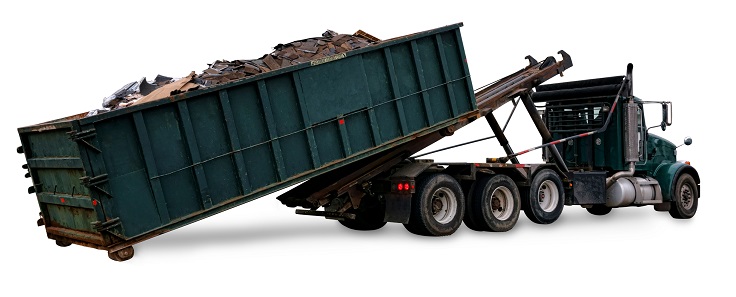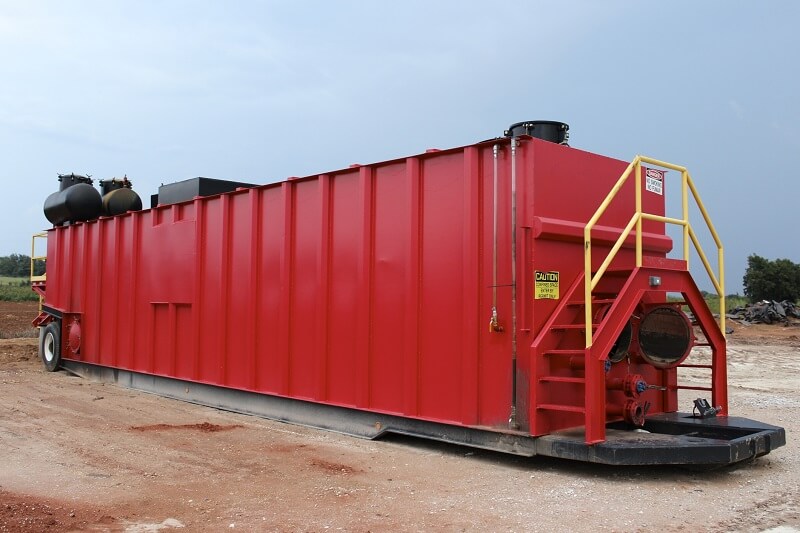Choosing the right container to haul away debris, sludge, and post-industrial cleaning waste is essential primarily for environmental compliance, but also for effective project management and cost considerations. Selecting the wrong hauling method can result in unwanted expenses, noncompliance with necessary ecological protection regulations, and unnecessary delays.
For industrial job sites, frac tanks and roll-off containers are two of the most commonly used methods to haul away unwanted material. Each has unique benefits and uses. Knowing whether you need a roll-off container or a frac tank ultimately depends on what needs to be hauled. Still, there are specific considerations that must be taken into account in the decision-making process.
What Is a Frac Tank?
A frac tank is a steel container that provides secure storage for waste commonly generated after industrial cleaning. Frac tanks can also store hazardous materials or liquids commonly found in industrial sites, construction jobs, and environmental work, as they are an approved container type for the EPA. A frac tank is widely used for dewatering and collecting wastewater after industrial cleaning and maintenance is conducted.
For example, if an industrial company uses hydroblasting, it may use a frac tank because the cleaning process involves using pressurized water to remove contaminants, debris, sludge, and other buildup from the surfaces of industrial equipment.
The resulting mix of water and the unwanted buildup is toxic and must be treated properly; it should not be allowed to simply run off into the sewer or groundwater, as this could contaminate them. Contamination could result in substantial fines, in addition to harming the environment.
This is where a frac tank comes in. It can collect the runoff, allowing it to be hauled away and adequately treated.
What Is a Roll-Off Container?

Conversely, roll-off containers are what they sound like. It’s typically a large, rectangular bin that is carried by a specialized truck that can move the container on and off its chassis. The roll-off container is rolled off the car at the job site or desired location, where it can be used to collect debris. Roll-off containers are commonly used to collect, contain, and haul solid waste, sludge, debris, and even dewatered waste.
Roll-off containers don’t just come in one rectangular type. There are several types of roll-off containers available, each suited to the customer’s specific needs. Often, people think of open-top dumpsters, which are a recognizable type of roll-off containers. However, roll-off containers can also come with a closed top.
Additionally, roll-off containers can be equipped with a dewatering screen, which filters out solid debris from the liquid waste. Additionally, there are vacuum boxes that are completely sealed. Vacuum boxes would be suitable for hazardous sludge.
Differences Between Frac Tanks and Roll-Offs
While both frac tanks and roll-off containers share some similarities, there are significant differences in how and when they are used, what they are ideally suited for, their size and capacity, as well as costs, mobility, and setup.
When it comes to when and how they are used, frac tanks are specifically designed for storing and hauling liquids. While some roll-off containers, like vacuum boxes or dewatering containers, can handle it, frac tanks are the better option for liquids. Roll-off containers are the better option for solids, construction debris, and mixed materials.
How to Choose the Right Option
When considering whether you need a frac tank or a roll-off container, several key factors must be taken into account in our decision-making process. The biggest concern, of course, is what needs to be stored and what needs to be hauled away. Cost should be a consideration, but not at the expense of the needs.
By evaluating the type of material that needs to be stored and hauled, you will be better equipped to select the most suitable option. Think about the type of material, whether it is liquid or solid, hazardous or non-toxic, how much volume of waste you might have, what space you have available for a drop off, how long you will need it, and what is required by environmental regulations.
Consider Regulations and Environmental Requirements
Especially when it comes to dealing with liquid waste, frac tanks are typically going to be the better option when it comes to storing and hauling wastewater or contaminated liquids. Especially if an industrial cleaning process requires the use of chemicals, the wastewater must be treated with care and in accordance with EPA guidelines, the Clean Water Act, and the Resource Conservation and Recovery Act.
Spill containment is a major issue with roll-off tanks, unless they are vacuum boxes, because there is a chance that material could seep or splash out of the container. Solid and dewatered waste isn’t as stringently regulated as liquid waste, so that’s why it’s absolutely crucial to have the proper container.
Failing to comply with these federal regulations could result in significant repercussions for the facility, particularly if it is found to be in noncompliance with the regulations. Costly fines, reputation damage, and even potential shutdowns could substantially impact the company in a negative way.
Set Up Frac Tank Rental
If you have liquid or dewatered waste that needs to be hauled away, and you’re ready to set up a frac tank rental, the team at Environmental Remedies can assist you. With over 30 years of experience working with industrial clients, we have become the first choice for industrial cleaning and waste treatment solutions in not just Georgia, but throughout the entire Southeast. Our team is dedicated to helping our customers make informed decisions that benefit their companies.
Even if you’re still unsure whether you need a roll-off or a frac tank for your industrial job site, we can help you make the right decision. Our team will help determine the best option for your needs. Reach out to us for more information about frac tank rental and more!
Frequently Asked Questions
Q: What is a frac tank used for?
A: A frac tank is designed for large-scale storage and transport of liquids such as wastewater, chemicals, and other hazardous materials. It’s commonly used in industrial cleaning, environmental remediation, and oil & gas operations.
Q: How much liquid can a frac tank hold?
A: Most frac tanks hold around 21,000 gallons of liquid, though capacities may vary depending on the model and manufacturer.
Q: Can a roll-off container hold liquids?
A: Standard roll-off containers are designed for solids, but specialized roll-off types like vacuum boxes or dewatering containers can hold and process liquid waste.
Q: Are frac tanks required for EPA compliance?
A: If you’re storing or transporting hazardous liquids or contaminated wastewater, a frac tank is often required to meet EPA regulations, including the Clean Water Act and Resource Conservation and Recovery Act.
Q: When should I choose a roll-off container instead of a frac tank?
A: If you’re handling construction debris, sludge, or other solids — especially if your waste is not regulated as hazardous liquid — a roll-off container is typically the more cost-effective and space-efficient choice.






